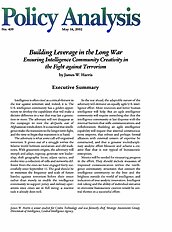The adversary is what some call self-organized terrorism. It grows out of a struggle within the Islamic world between secularism and old traditions. With grassroots origins, the adversary will morph and adapt, regroup, generate new leadership, shift geographic locus, adjust tactics, and evolve into a collection of cells and networks different from the ones we have engaged fairly successfully since September 11. The goal should be to minimize the frequency and scale of future battles against terrorism before their onset rather than merely to enable the intelligence community to support policy and military operations once crises are in full swing–a reactive task it already does well.
In the war ahead, the adaptable nature of the adversary will demand an equally agile U.S. intelligence effort. More resources and better human intelligence will help. But an agile intelligence community will require something else: that the intelligence community at last dispense with the internal barriers that stifle communications and collaboration. Building an agile intelligence capability will require that internal communications improve, that robust and perhaps formal alliances with external centers of expertise be constructed, and that a genuine multidisciplinary analytic effort blossom and achieve a creative flair that is not typical of bureaucratic enterprises.
Metrics will be needed for measuring progress in the effort. They should include measures of improved communication within the intelligence community, structures that connect the intelligence community to the best and the brightest outside the world of intelligence, and indicators of true analytic innovation. Intelligent risk taking and the ability of individual initiative to overcome bureaucratic caution would be central themes in a successful effort.

